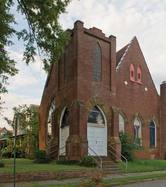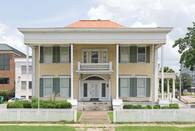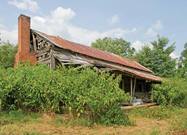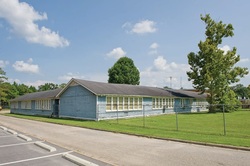 Click image to enlarge.
Click image to enlarge.
 Click image to enlarge. Click image to enlarge. Painted Bluff is one of Alabama’s most special places. Dating from the Mississippian Period (c. 1400), the six-hundred-year-old site contains more than eighty individual glyphs located along two separate bluff s overlooking the Tennessee River. These red, yellow, and orange symbolic images include people, ovals, circles, snakes, birds, and other animals. Open air rock art sites of this type are unique to the Southeast, and Painted Bluff represents one of the most significant in the region.
2 Comments
 Click image to enlarge. Click image to enlarge. Old Grace Episcopal is among the oldest churches in Sheffield. Constructed in 1903, it is a brick and stone building designed in the Late Victorian Gothic style. In 1963 the Episcopal Diocese sold the building and parishioners moved to a suburban location. Various congregations used it afterwards. Maintenance of the structure remains a concern, and leaks in the roof contribute to ongoing moisture damage in the building. The original woodwork and historic fixtures remain, but previous owners removed the stained glass and pews.  Click image to enlarge. Click image to enlarge. Elegant nineteenth- and early twentieth-century mansions once lined Greensboro Avenue in Tuscaloosa. Today, the George Searcy House is one of the few surviving buildings from that era. At a time when “Old South” nostalgia was gaining popularity, Searcy, a prominent local businessman, chose large Ionic columns for the front of his home. The building retains many of its original details, including an unusual cylindrical spiral staircase salvaged from an earlier Tuscaloosa home. However, the six massive columns that once graced the imposing facade were removed.  Click image to enlarge. Click image to enlarge. The Urquhart House is one of Madison County’s oldest buildings. Still retaining its original Federal period decorative elements (the mantles, windows, and door trim are still intact), the structure illustrates the evolution of a one-room log cabin into a larger, five-room house. The home sits on land transferred to Allen Urquhart on December 2, 1813.  Click image to enlarge. Click image to enlarge. From 1949 to 1968, the Rosa A. Lott School in Citronelle was the only African American high school in northern Mobile County. Under the leadership of local educator Rosa Amelia Lott (1903–1952), the Citronelle Consolidated School provided education for first through twelfth grades. Local students and other children from at least eighteen communities in Mobile and Washington Counties attended the school. Prior to its construction, parents had to send their children away to attend high school. Some traveled more than thirty miles to get an education, and many children were forced to live away from home, boarding or staying with family in distant communities during the school year. |
Alabama's Endangered Historic LandmarksEach year since 1994, Alabama Heritage has highlighted threatened historic sites throughout Alabama. The “Places in Peril” list has identified more than 215 imperiled historic resources throughout the state, and is compiled by the Alabama Historical Commission and the Alabama Trust for Historic Preservation. The locations highlight the results of deferred maintenance, perceived obsolescence, development pressures, and lack of funding—forces that now more than ever threaten our cultural legacy. But awareness is a powerful force, too, and can cultivate a renewed determination to be responsible stewards of our heritage. For more information, visit the AHC or the ATHP websites. Alabama Heritage is proud to bring to you a selection of the places designated as perilous. Please keep your comments to information relevant to the featured place in peril. Alabama Heritage reserves the right to delete any comment that we deem inappropriate. Archives
May 2024
|

 RSS Feed
RSS Feed